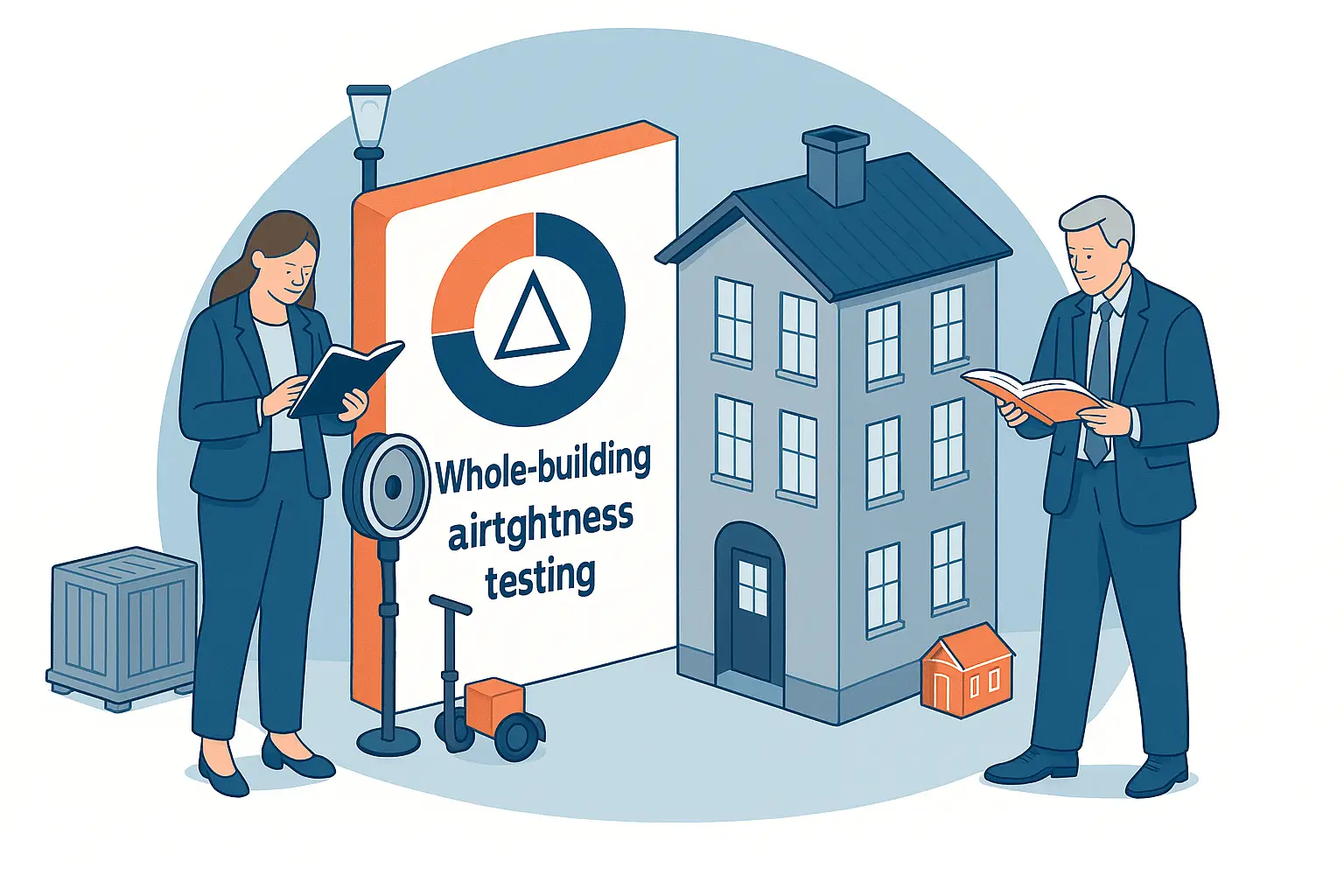Airtightness Testing: A Critical Component in Whole-Building Life Cycle Assessments
In today’s rapidly evolving construction landscape, sustainable building practices have become paramount. Among these practices, airtightness testing plays a pivotal role in evaluating the overall performance and environmental impact of buildings. Ratio Seven recognises the integral part that airtightness testing plays in creating energy-efficient structures, reducing carbon footprints, improving indoor air quality, and ensuring the durability of buildings throughout their lifecycle.
Impact on Energy Efficiency and Operational Emissions
Whole Building Airtightness Testing (WBAT), often conducted through blower door testing, is an essential method to assess the integrity of a building’s envelope in preventing air leakage. Air leakage can significantly affect energy efficiency, leading to heat loss in cooler climates and heat gain in warmer climates. This can result in increased energy demands for heating and cooling, which in turn heighten operational energy consumption and carbon emissions. By reducing air leakage, buildings can achieve substantial reductions in energy use and associated emissions, underlying the importance of airtightness within Whole Life Carbon Assessments.
Contribution to Whole Life Carbon Assessments
Whole Life Carbon Assessments (WLCA) analyse the total carbon emissions associated with a building throughout its lifecycle, from initial construction phases to eventual demolition or redevelopment. Airtightness testing is a fundamental aspect of WLCA as it directly influences the building’s operational carbon footprint. Buildings that achieve optimal airtightness require less energy for temperature regulation, thereby substantially decreasing operational carbon emissions over their lifespan. This reduction is crucial not only for meeting sustainability goals but also for aligning with global carbon reduction targets.
Influence on Indoor Air Quality and Durability
A crucial, yet often underestimated, benefit of airtightness is its impact on indoor air quality (IAQ) and the durability of the building. By effectively managing air leakage, buildings can also control moisture levels, reducing the risk of mould growth and structural damage. This protection against moisture contributes to a building’s longevity and reduces the need for extensive maintenance, aspects that are critical in life cycle assessments. Better IAQ enhances occupant health and comfort, while increased durability ensures buildings remain environmentally friendly and economically viable in the long term.
Compliance and Benchmarking
The importance of airtightness testing is highlighted by its inclusion as a mandatory requirement in various jurisdictions around the world. These regulations ensure that both new and existing buildings meet specific airtightness performance standards. Compliance with these standards helps to homogenise quality, enabling benchmarking against industry norms and best practices. For construction professionals, including those at Ratio Seven, this allows for the consistent application of airtightness standards, significantly simplifying the process of life cycle performance comparisons for buildings.
Data Collection and Analysis
A wealth of data is produced from airtightness testing, offering invaluable insights into the performance characteristics of different buildings. This information, encompassing variables such as building height, storey number, age, and envelope structure, is crucial for comprehensive life cycle assessments. Building professionals and organisations like Ratio Seven utilise this data to set precise airtightness targets for new constructions and refurbishments of existing buildings. The database aids in refining design strategies, ultimately leading to enhanced building performance and compliance with green building standards.
Beyond Energy Efficiency: The Multifaceted Benefits of Airtight Buildings
Aside from reducing energy use and operational emissions, achieving airtightness in buildings delivers a multitude of benefits. It enhances occupant comfort through improved thermal regulation and noise reduction. Airtight buildings maintain their temperature more effectively, ensuring a consistent indoor environment free from external temperature fluctuations or unwanted draughts. Additionally, airtightness aligns with acoustic insulation principles, providing quieter indoor spaces shielded from external noise sources, an increasingly desirable trait in urban areas.
Challenges and Considerations in Airtightness Testing
While promising numerous benefits, achieving optimal airtightness involves overcoming several challenges. These include addressing construction defects, such as gaps or cracks in the building envelope, that can lead to significant air leakage. Careful consideration is necessary during the design and construction phases to ensure these potential issues are mitigated. Training and awareness for construction teams regarding best practices for airtight sealing techniques are essential for ensuring consistent results across different projects.
The Role of Technology in Airtightness Testing
Advanced technologies and methodologies are constantly being developed to enhance the accuracy and efficiency of airtightness testing. Innovations such as infrared thermography and tracer gas testing provide detailed insights into building performance, allowing for targeted interventions to improve airtightness. As these technologies evolve, they contribute to the ongoing optimisation of building designs and construction methodologies, ensuring that future buildings achieve even higher levels of airtightness and performance.

Conclusion: The Future of Airtightness Testing in Sustainable Building Practices
Airtightness testing is a vital component of whole-building life cycle assessments. Its role extends beyond energy efficiency, influencing an array of factors including operational carbon emissions, indoor air quality, occupant comfort, and building durability. As environmental standards rise and construction practices evolve, the importance of airtightness will only increase. Companies like Ratio Seven continue to pioneer efforts in promoting airtightness testing, leveraging advanced technologies and data-driven insights to enhance building performance sustainably and efficiently.
FAQs
What is whole-building airtightness testing?
Whole Building Airtightness Testing, or blower door testing, evaluates how effectively a building’s envelope prevents air leakage. It involves creating a pressure difference between inside and outside and measuring air infiltration rates, providing data on potential heat loss or gain due to air leaks.
Why is airtightness important in energy efficiency?
Airtightness is crucial for energy efficiency as it minimises air leakage, thereby reducing the need for excessive heating or cooling. This leads to lower energy consumption, reducing both energy costs and carbon emissions associated with maintaining comfortable indoor temperatures.
How does airtightness affect indoor air quality?
Airtightness has a significant impact on indoor air quality by regulating moisture levels and preventing pollutants from entering the indoor environment. By controlling unwanted air leaks, buildings can maintain healthier indoor environments that enhance occupant well-being.




